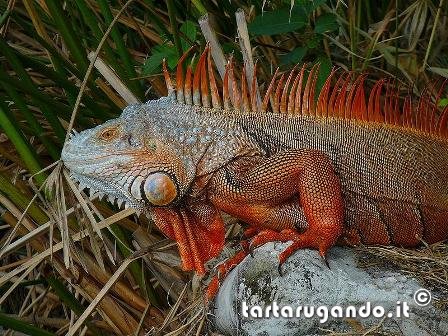
Kingdom: Animalia
Subkingdom: Eumetazoa
Phylum: Chordata
Subphylum: Vertebrata
Superclass: Tetrapoda
Class: Sauropsida (Reptilia)
Subclass: Diapsida
Interclass: Lepidosauromorpha
Superorder: Lepidosauria
Order: Squamata
Suborder: Lacertilia (Sauria)
Interorder: Iguania
Family: Iguanidae
Genus: Iguana
Iguana iguana iguana (Linnaeus 1758), Iguana iguana rinolopha (Wiegmann 1834)
When you are in a pet store, whether it is specialized in reptiles or not, we are often attracted by puppies Green Iguana that for sure encourages the purchase. Unfortunately, a little for ignorance, a little to sell the puppy, the shopkeeper hardly tell you what you are going to encounter. So before you buy one, it is crucial gather information and assess whether you are able to offer a healthy and dignified life. It's a reptile very territorial and must also consider the character to 95% of cases is aggressive and dominant. It's a diurnal reptile. Like all reptiles, is a cold-blooded animal or ectothermal and vital functions/metabolism need heat from the environment to activate. The Iguana in the wild has a very static life. Lives in trees most of the time. In the morning, with the first light, tends to move where the sun warms up more, and when the body temperature reached "optimal", begins the search for food. The diet is totally herbivorous, although sometimes traces of insects were found in the feces, due to the random presence of the latter on the leaves and the fruits ingested. Digestion is another reason to "relax" in the sun .... to digest needs continuously to maintain high body temperature (around 30 ° C). Its habitat, however, is very humid during the day in their areas of origin you arrive safely at 90-95%. It is not a predator lizard, which is why an Iguana that lives up to 15 years in the wild is considered very lucky! The "danger" to them, usually comes from above: birds, large birds of prey are the most fearsome predators. For this reason, for the coupling or simply looking for food, comes down from trees. In case of "imminent" danger does not hesitate to launch even from great heights. It's a very good swimmer, water provides good protection, so that, on trees in the vicinity of a watercourse is easy to look up and see an iguana among the branches. In the evening, the sunset and the lowering of temperatures, finds a branch repaired to spend the night on.
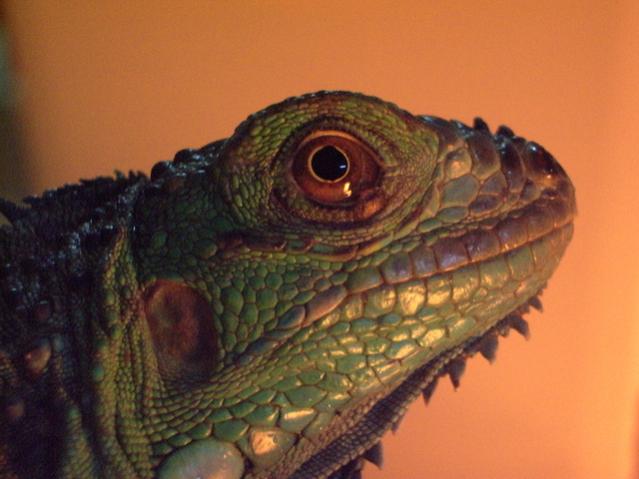
In captivity everything changes! By purchasing an iguana, the first thing to do is a vet check-up, with a stool test for bacteriological and parasitological research (this is a rule to be applied always and for all animals, not just for reptiles). The phase from 0 to 6 months is the most delicate and perhaps more risky in the life of an iguana. We must consider the veterinarian, not only as the one who takes care of the animals, but as an expert who has a clear and consistent clinical picture of the animal, able to intervene promptly in case of need. The visits are to be repeated every 6 months. For reptiles, it is necessary to consult a specialist (veterinarian specializing in reptiles).
It is one of the lizards most difficult to keep, for the size to which arrives (even 180cm), for the lights, the humidity, the distribution of heat sources, diet, requires much commitment and daily care. It's a reptile, in spite of its appearance "massive and severe", very delicate, because it takes very little to get sick! It’s strongly discouraged for a beginner!
Terrarium, the first step
Material generally used is plywood, very resistant to moisture and temperature, building each wall with a double layer, using insulating material such as glass wool and / or polystyrene to fill the space between the two layers. A showcase for an iguana, you will find hardly ready for sale, due to the size it has. For a puppy should be (minimum size) 120 cm high, 120 cm long, 60 cm deep. My advice is to build already the definitive one (200cm high, 200cm long and 120cm deep), due to the speed of growth of an iguana from 0 to 18 months. In both cases, the vents will be placed on the sides with by the size to be decide depending on the materials chosen for the construction and thermal insulation (it's always recommended adjustable ones!). Re-creating a microclimate in showcases of this size, it requires heating and lighting (UVA-B), as well as humidity, properly and specifically arranged. The iguana is a diurnal reptile, therefore, the heat must come always and only from above. For this, there are mercury vapor lamps (or also called HQL, hydrargyrum quartz iodide). The power of HQL varies from 100 to 160w. In addition to functioning as a primary heat source, it is also the only correct way, due to the size of the case, to irradiate the iguana with UVA-B, along with vitamin D3 necessary for the fixation of calcium. The HQL have radiation that reaches beyond 150cm. Generally, mounting a mercury vapor lamp, you do not need the neon (tube) to 5%. I suggest, however, especially in definitive terrarium, for proper lighting, the installation of two tubes to 5% from 30-36w. By turning on the empty terrarium, you will evaluate the occurrence of an additional source of heat.
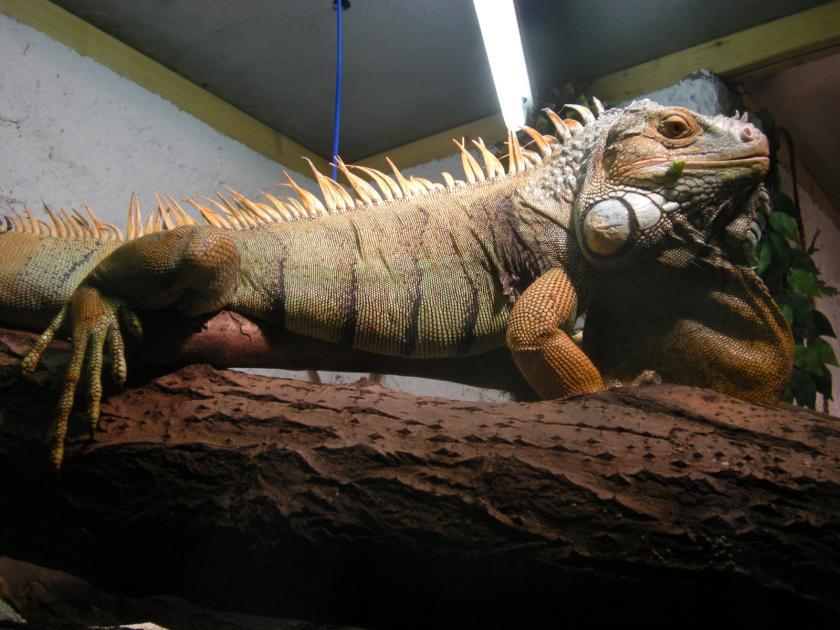
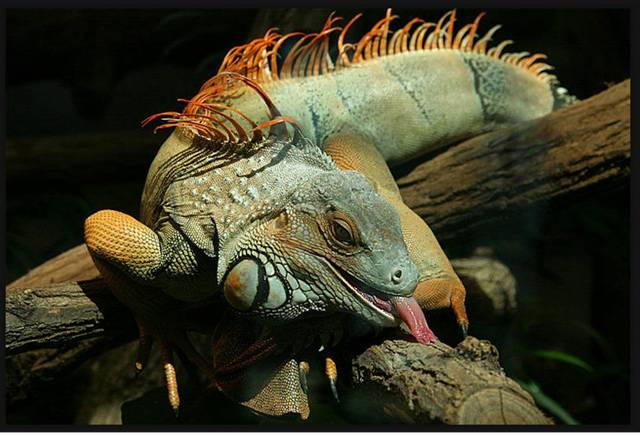
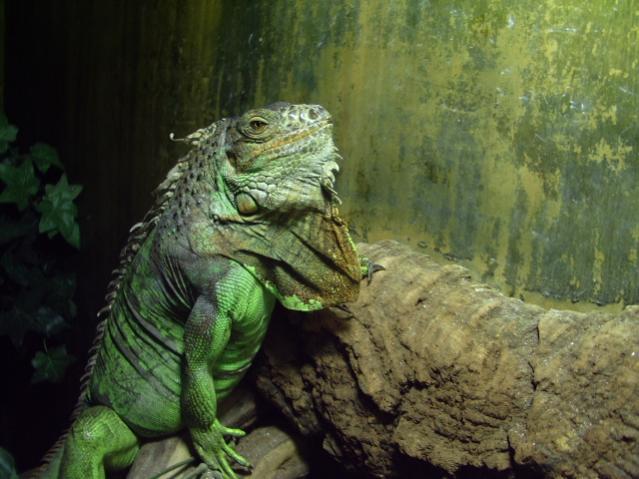
Daytime temperatures will be divided into three zones: the hot, under the mercury vapors can reach 32-35° C but generally at a distance of 40-50 cm drops on 30 ° C. An intermediate zone, with temperatures between 26 and 28 ° C and a third area where fall between 24 ° c and 26 ° C. In this way, the reptile will be able to thermoregulate. Attention, all HQL should not be thermostated. During the night, and you are using only the ceramic lamps that doesn’t emit light, allowing proper rest of the Iguana. The temperature will be controlled by a thermostat which will be regulated on 22-24 ° C. It’s always better to use thermostats with external probe. The thermostat probe and the ceramic lamp will be positioned where the iguana uses to sleep. For a proper air circulation, it is best to place the "park lamps" on the side where the vents are at the bottom. It’s extremely important to shield the lamps. The reaction times (of reptiles in general) are slow to heat and the iguana could take severe burns, noticing only when it is already too late. Humidity is very important.
In the terrarium will get a large washing tray, deep enough to allow the iguana to submerge completely. Under it, you will use a Silicone wire, at least 50w, leaving it permanently switched on and thermostating it at 24-25 ° C. The evaporation of water will favor the rise of moisture. There are also humidifiers which, by means of a timer or a probe, guarantee an optimal gradient. These systems have relatively low prices. Ultrasound systems, which cost far less, are virtually useless if not harmful, the mist produced tends to decrease the temperatures and, in the case of contact, can cause severe burns. For the furniture of the terrarium can be used dry branches of plants that are not toxic (eg. Conifers), with diameter and structure big enough and strong enough to bear the weight of the Iguana. Real plants are to be avoided, although most aesthetically beautiful and able to better maintain the moisture gradient, the iguana would die in a short time if toxic and may cause serious problems to our pet. There are fake plants really nice and affordable. You can create fake rocks and backgrounds by using polyurethane, polystyrene tile adhesive flatting paint and non-toxic. Respecting the natural colors of its habitat and remembering not to stifle the environment, you can give free will to all your creativity. A final terrarium 200 x 120 x 200 is just enough for a single specimen. Try to buy them all devices online, surely you will save a lot of money!
Being a reptile very territorial, even the coexistence of different sexes in the same terrarium can be very dangerous. So, it is always the rule of raising a single pair in a terrarium.
Feeding
As stated previously, it is a herbivore reptile. Therefore, the diet should be exclusively vegetables. Whatever animal protein intake, would cause serious damage to kidneys and liver digestive organs. A 80% of the total food will consist of green leafy vegetables (chicory of any kind, and smooth curly endive, radicchio (Italian chicory), arugula, endive, dandelion greens, grape leaves, mulberry leaves, blades of prickly pear peeled - not the fruit....). It’s not recommended the administration of pellets plant since the iguana hardly drink and hydration necessary to assume from the power. Are not to be give lettuce, cabbage, cabbage and the similar. A 15% will consist of vegetables such as zucchini, carrots, green beans, peppers. The remaining 5% will be made up of fruits, possibly seasonal, such as apples, figs, pears, peaches, oranges and tangerines, Hibiscus flowers, dandelion flowers, roses. Are not recommended fruits like banana and grapes. When feeding puppies should cut vegetables and fruit finely for easier swallowing.
Integration
The integration calcium / vitamin it’s important. The iguana bred in captivity, is unlikely to enjoy sunlight, therefore will not be able to synthesize vitamin D3, which is essential for the establishment of calcium. For this reason there are supplements (repticalcium + D3, Necton MSA) containing only calcium carbonate and vitamin D3 powder with which sprinkle the vegetables 2-3 times per week (except veterinary different directions). It’s extremely important sprinkling the vegetables with only pure calcium carbonate powder every day. This is easily available in pharmacies at a price that can vary from 8 to 12 € per kg. There are multi vitamin supplements for reptiles, that can be give only once every 10-15 days.
Basically, a wrong diet and supplementation could bring your lizard to death.
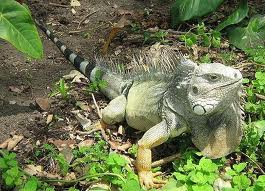
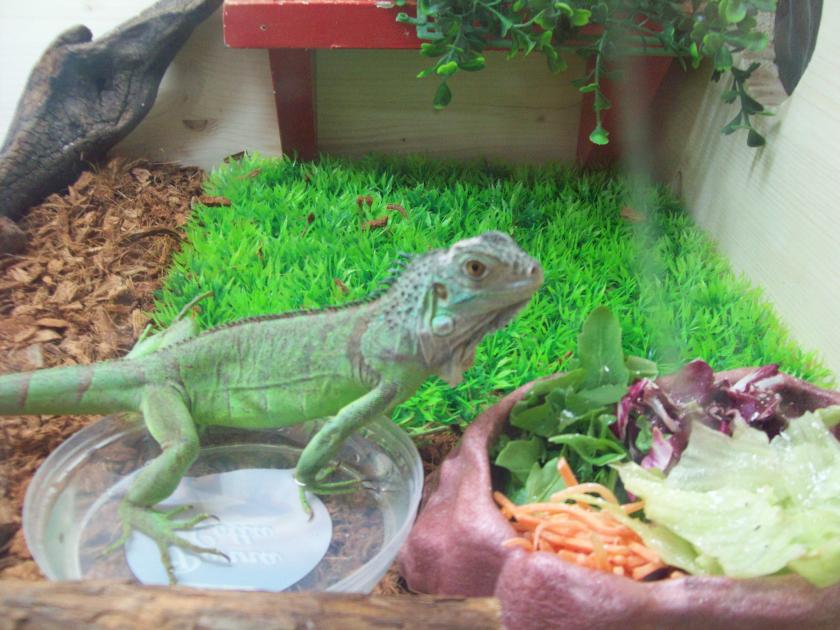
Illness, diseases
First of all I'm not a vet but a breeder,so I can limit myself to describe the diseases and the most common problems. Stress: the reptiles do not like to be touched! The interaction with humans or other animals, but also the mere sight or loud noises and sudden movements cause stress that could lead to death !
MOM, metabolic bone disease, due to a hypocalcaemia usually caused by a bad feeding or integration, lack of suitable lights. This disease causes, as well as problems with internal organs, strains, and spontaneous bone fractures.
The Salmonella (some types are also hazardous to humans) that harms reptiles, proliferates at 30 °C, so it is not able to survive at the temperature of the human body. A bacteriological examination of the feces will reveal the possible presence. It’s a good idea not to handle the reptiles unless absolutely necessary and use protective gloves, salmonella is transmitted by the oral rectal way! Wash your hands with warm water and an antibacterial soap will help to avoid any problem.
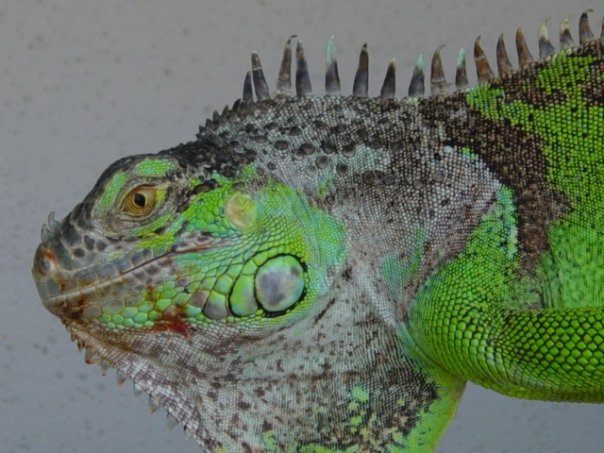
Reproduction
Having never reproduced this lizard and not having the support of people who have reproduced, I can only recommend the constant monitoring of a veterinarian specializing in reptiles. Clearly, male and female must meet only for mating and only if the female is ready.
Before buying an iguana, inquire well. Think of the space that will serve, to the constant commitment it requires, it is a reptile with a particular character, the money for the terrarium equipment and bills, it is not a mammal and not a toy! It's a reptile protected by the Washington Convention in Annex II, requires CITES documentation
Below is a list of necessary equipment, which clearly will vary depending on the size of the cage and terrariums. Before putting the iguana in terrarium, it is advisable to monitor all parameters and make any necessary changes.
1 or 2 neon uv 5% (power proportionate to the size of the terrarium) *
1 mercury vapor lamp type Powersun 100 / 160w (depending on the size of the terrarium)
1 ceramic lamp (there are 50 to 200W) ("" "" "")
1 silicone heating cable minimal power 50w ("" "" "")
1 hygrometer
2 thermostats with sensor
2 thermometers, better with probe
2 timers
1 or 2 multi socket protected (optional but highly recommended!)
Nekton MSA - Repticalcium + D3 (vit d3 supplement)
Pure calcium carbonate powder (in pharmacy)
1 nebulizer machine or a common spray bottle for water
1 bowl for water (you can use a cat litter, just below it you place the cable)
* With lamp mercury vapor can also be used normal neon
* Neon uv 5% are found to DIY at great prices
* The purchase of equipment should always do so online at specialized sites
************************************************** ***************
Originally written by: Luca Pompilio
Translated by: Drakul
 Benvenuto su Tartarugando, il forum tematico specializzato nell'allevamento di tartarughe e di altri rettili.
Benvenuto su Tartarugando, il forum tematico specializzato nell'allevamento di tartarughe e di altri rettili.





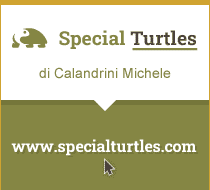
 Elenco delle sezioni
Elenco delle sezioni Elenco delle Categorie
Elenco delle Categorie Nuvola Tag
Nuvola Tag

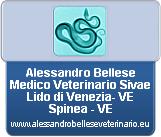

 Articoli recenti
Articoli recenti